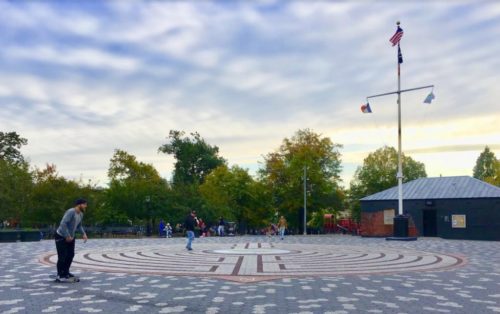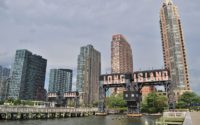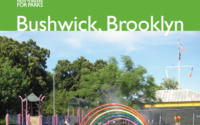Overused and under-maintained: How city’s rezoning plan could affect Bushwick’s parks
October 15, 2019
By Alex Williamson
A new report from nonprofit group New Yorkers for Parks highlights the need for more open space in Bushwick, and warns that the city’s proposed rezoning plan for the neighborhood, which is expected to bring in thousands of new residents, could strain Bushwick’s already scarce parkland.
The report found that, of 14 total “open space goals” — defined in some cases by the city’s own goals and in others by standards from groups like the Trust for Public Land — Bushwick was only meeting two: number of playgrounds and number of community gardens.
The categories where Bushwick falls short include total amount of open space — only .2 acres per 1,000 people, while the citywide goal is 2.5 acres per 1,000 people —and access to open space, based on how long it takes the average resident to walk to a park.
No Bushwick residents live within a five-minute walk to a large park, because the neighborhood has none. Less than 60 percent live within a five-minute walk to a smaller neighborhood park or pocket park.
According to the Trust for Public Land, people who have easy access to parks are more likely to exercise, weigh less and have increased aerobic capacity and better flexibility. In Bushwick, more than a quarter of children in kindergarten through eighth grade are obese, according to 2018 data from the city. The citywide average is one in five.
The neighborhood’s parks passed NYC Parks’ inspections for cleanliness only 80 percent of the time because of problems like graffiti, broken glass, weeds and litter. They passed maintenance inspections only 70 percent of the time, due to issues like crumbling pavement or broken equipment.
The report also found Bushwick’s tree canopy lacking, with only 14 percent of public space in the neighborhood shaded by trees.
Even though New Yorkers for Parks found that the number of playgrounds in Bushwick meets the citywide goal, residents reported feeling the neighborhood needed more. Lucy Robson, executive director of research and policy at the nonprofit, said that’s because the numbers don’t tell the whole story.
“We use data to get a baseline of open space conditions in neighborhoods like Bushwick, but we also talk with local advocates to understand if there are things that the data doesn’t tell us,” Robson told the Brooklyn Eagle in an email.
A lack of recreation centers and larger parks in the neighborhood could contribute to crowding at Bushwick’s playgrounds, for instance.
New Yorkers for Parks released a set of recommendations along with the report, including that land owned by the DOE and NYCHA in Bushwick be made accessible to the public where possible. No specific public housing sites or schools have been named.
More residents, more use
The Department of City Planning estimates that zoning changes in Bushwick could bring more than 5,000 new housing units to the neighborhood, along with more than 17,000 new residents.
Community Board 4 District Manager Celeste León warned that the city’s plan doesn’t provide the money to help Bushwick’s parks keep up with the expected influx of residents.
“Bushwick’s open spaces generally need dedicated funding for better day-to-day maintenance and operations,” she told the Eagle in an email. “The current plan doesn’t specify any of the capital needs in our parks either … or the pavement and walkways that are rapidly deteriorating.”
Since 2008, more than 5,000 new residential units have been built in Bushwick’s “R6” zoning, which allows construction with no height restrictions or affordable housing requirements.
To help steer the neighborhood’s development, Bushwick residents started working with City Council members Rafael Espinal and Antonio Reynoso in 2014 on the Bushwick Community Plan, which released an updated set of recommendations in 2018. In exchange for higher-density zoning along major transit corridors, the BCP asked for affordable housing and significant investment in community amenities — including parks.
Many of the BCP’s open space priorities, including renovating the comfort station in Maria Hernandez Park, were not included in the plan the city released in April.
Anessa Hodgson, a spokesperson for the city’s Parks Department, pointed out that Beaver Noll Park, a half acre park that cost $3 million, opened this past summer at Bushwick Avenue and Beaver Street, and that the department is spending $10 million on improvements to existing open spaces in the neighborhood.
Beaver Noll Park has been in the works since 2012, however, two years before the first rezoning meetings, and Bushwick community members have objected in the past to framing it and other normal city investments as trade-offs for higher residential density.
León says the lack of significant new investment, coupled with an influx of new residents, could cause the neighborhood’s already scarce parkland to shrink further or fall into disrepair.
“We already have a deficit of open space,” León said in a statement. “With new developments and people coming, our small existing spaces may suffer with increased use and insufficient resources.”
Read the full article on the Brooklyn Daily Eagle


